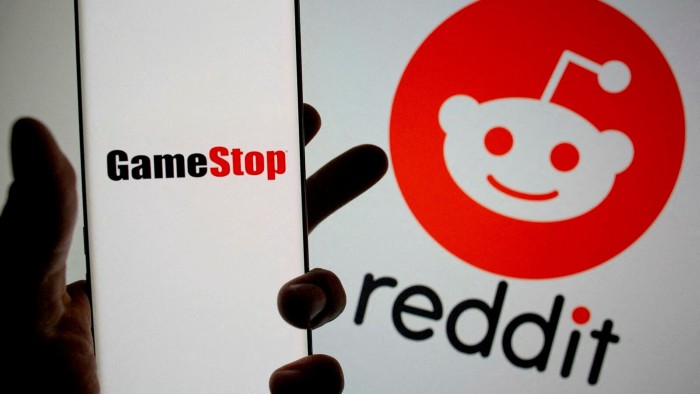Meme and thematic ETFs surge as inflation fears dip

Simply sign up to the Exchange traded funds myFT Digest -- delivered directly to your inbox.
Latest news on ETFs
Visit our ETF Hub to find out more and to explore our in-depth data and comparison tools
Beaten-up meme and thematic stock exchange traded funds have made dramatic gains in recent weeks, buoyed by signs of a possible peak in inflation and legislation paving the way for a boom in clean energy.
The meme stock ETFs that were emblematic of the growth stock-fuelled market rallies of 2020 and 2021 have surged, with the Roundhill Meme ETF (MEME) up 24 per cent since its low on July 26, after plunging 60 per cent since its December launch. The VanEck Social Sentiment ETF (BUZZ) is up 17 per cent, partially reversing a 49 per cent slide from its November highs, and the SoFi Social 50 ETF (SFYF) up 16 per cent after a 43 per cent slump.
The animal spirits buoying meme ETFs have also lifted those targeting renewable energy stocks, housing, infrastructure and robotics, which have enjoyed strong inflows, in many cases after having endured chunky outflows since equity markets peaked late last year.
Ark Invest’s high-profile Innovation ETF (ARKK), a barometer of enthusiasm for a swath of punchy technology stocks often trading at speculative valuations, has also clawed back 14.8 per cent since July 26, recovering a small slice of its 65 per cent loss since November.
The funds all undershot the S&P 500’s slide on the way down but have beaten its 7.4 per cent rise since late July, living up to their billing as sentiment-driven, high-beta investments beloved by the Reddit WallStreetBets crowd.
Several renewable energy ETFs have also ridden the same wave, with the Invesco Solar ETF (TAN) jumping 21 per cent since July 26, the iShares Global Clean Energy ETF (ICLN) rising 20 per cent and the First Trust Nasdaq Clean Energy Index Fund (QCLN) firming 22 per cent.
“These funds tend to be high beta, so it shouldn’t be too surprising that as the US equity market has ticked up again, that these funds too have recovered some ground over recent weeks,” said Kenneth Lamont, senior fund analyst for passive strategies at Morningstar.
The primary catalyst appears to be mounting expectations that runaway US inflation is close to peaking or has already done so, potentially allowing the Federal Reserve to ease up on its rate hiking cycle later this year and begin cutting rates in 2023.
This in turn feeds through into a lower interest rate used to discount the future profits expected for high-growth companies.
“Investors are more comfortable that the Federal Reserve is going to be able to slow the economy and avoid recession, and these investors are willing to take on more risk heading into the fourth quarter and 2023,” said Todd Rosenbluth, head of research at VettaFi.
A second driver, for some stocks at least, appears to have been Senate approval of the Inflation Reduction Act, which among other things clears the way for the largest single investment in clean energy and climate programmes in US history.
“Legislation supporting clean energy efforts has been a benefit to related stocks, perhaps tempting tactical or growth-oriented investors off the sidelines,” said Lois Gregson, senior ETF analyst at FactSet.
Rosenbluth saw this trend as having more legs.
“The pending climate change-fighting legislation has renewed interest in renewable energy and other thematic ETFs. Those likely have more staying power than less profitable companies benefiting from interest via memes,” he said. “Meme investing seems to be an eclectic and amorphous group of companies that gain a following and then that following peters out.”
ETF investors — if not necessarily those in the underlying stocks — appear to agree with this prognosis. TAN, ICLN and QCLN took in a combined $291mn in the two weeks to August 5, according to FactSet data, having shipped $1.2bn since the start of November 2021.
The surge in enthusiasm for these narrow bets is in contrast to that for US stocks at large, with three broad market ETFs — Vanguard S&P 500 (VOO), iShares Core S&P 500 (IVV) and SPDR S&P 500 ETF (SPY) — seeing collective inflows of only $1.9bn in the fortnight to August 5, no pick up in the pace of flows, which have hit $55.3bn since November.
Despite the surge in the price of meme ETFs, investor enthusiasm for the vehicles seems sparse, with most such ETFs seeing flat or slightly negative flows in recent weeks, according to FactSet, even as key holdings such as Coinbase and AMC Entertainment have jumped 70 per cent or more since late July.
Social media-driven sentiment for their underlying holdings certainly seems to be back, however.
Marina Goche, chief executive of Sentifi, an alternative data provider, said it saw a sharp rise in “chatter” on social media, news forums and blogs around stocks such as Bed Bath & Beyond (up 125 per cent since late July), AMC and GameStop even before their price surges.
“Much like last year, alternative sentiment data has again come to the fore as an important tool for indicating early murmurs of price, with a lot of market signals happening in online forums like Reddit before the price moves,” said Goche.
“I was surprised that this trend of investing has re-emerged. It wasn’t just a one-time fad, but there are more prudent ways for ETF investors to put money to work,” Rosenbluth said.

Click here to visit the ETF Hub
Comments